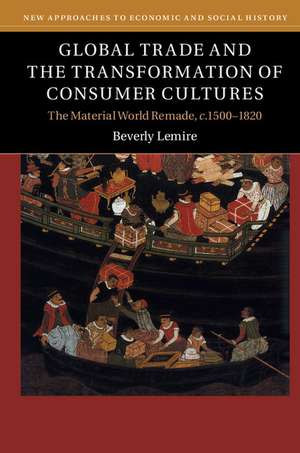Global Trade and the Transformation of Consumer Cultures: The Material World Remade, c.1500–1820: New Approaches to Economic and Social History
Autor Beverly Lemireen Limba Engleză Paperback – 10 ian 2018
| Toate formatele și edițiile | Preț | Express |
|---|---|---|
| Paperback (1) | 244.27 lei 43-57 zile | |
| Cambridge University Press – 10 ian 2018 | 244.27 lei 43-57 zile | |
| Hardback (1) | 644.73 lei 43-57 zile | |
| Cambridge University Press – 10 ian 2018 | 644.73 lei 43-57 zile |
Preț: 244.27 lei
Nou
Puncte Express: 366
Preț estimativ în valută:
46.74€ • 48.92$ • 38.90£
46.74€ • 48.92$ • 38.90£
Carte tipărită la comandă
Livrare economică 31 martie-14 aprilie
Preluare comenzi: 021 569.72.76
Specificații
ISBN-13: 9780521141055
ISBN-10: 0521141052
Pagini: 370
Dimensiuni: 152 x 228 x 22 mm
Greutate: 0.59 kg
Editura: Cambridge University Press
Colecția Cambridge University Press
Seria New Approaches to Economic and Social History
Locul publicării:Cambridge, United Kingdom
ISBN-10: 0521141052
Pagini: 370
Dimensiuni: 152 x 228 x 22 mm
Greutate: 0.59 kg
Editura: Cambridge University Press
Colecția Cambridge University Press
Seria New Approaches to Economic and Social History
Locul publicării:Cambridge, United Kingdom
Cuprins
1. Early globalisation, rising cosmopolitanism and a new world of goods; 2. Fabric and furs: a new framework of global consumption; 3. Dressing world peoples: regulation and cosmopolitan desire; 4. Smuggling, wrecking and scavenging: or, the informal pathways to consumption; 5. Tobacco and the politics of consumption; 6. Stitching the global: contact, connection and translation in needlework arts in the sixteenth to nineteenth centuries; 7. Conclusion: realising cosmopolitan material culture.
Recenzii
'This exquisitely crafted book transforms our understanding of early modern material culture and provides a new global framework of analysis. Lemire shows how cloth and clothing, fur, tobacco and other global commodities reshaped people's habits, social practices and material expectations in different parts of the world.' Giorgio Riello, University of Warwick
'Beverly Lemire, a leading scholar of the history of European fashion, clothing and consumer culture, suggests that changes to consumer consumption in the early modern period were inherently global. In so doing, she refocuses the agents of globalization from Europe to the globe, from elites and the middle class to the subaltern, and from where things are produced to where people live their lives.' Kaoru Sugihara, Research Institute for Humanity and Nature, Kyoto
'Lemire takes the study of early globalization and material culture a large step further with this book. Cosmopolitan consumption, her term for the integration of new goods into the material cultures of the world's peoples, succeeds in creating a truly global history of evolving consumer practices. This study abounds with fresh insights into the agency of goods and agency of ordinary people.' Jan de Vries, University of California, Berkeley
'… an important project dedicated to decentering our understanding of global commodity flows through both written and material cultural evidence.' Jane Hooper, Canadian Journal of History
'Beverly Lemire, a leading scholar of the history of European fashion, clothing and consumer culture, suggests that changes to consumer consumption in the early modern period were inherently global. In so doing, she refocuses the agents of globalization from Europe to the globe, from elites and the middle class to the subaltern, and from where things are produced to where people live their lives.' Kaoru Sugihara, Research Institute for Humanity and Nature, Kyoto
'Lemire takes the study of early globalization and material culture a large step further with this book. Cosmopolitan consumption, her term for the integration of new goods into the material cultures of the world's peoples, succeeds in creating a truly global history of evolving consumer practices. This study abounds with fresh insights into the agency of goods and agency of ordinary people.' Jan de Vries, University of California, Berkeley
'… an important project dedicated to decentering our understanding of global commodity flows through both written and material cultural evidence.' Jane Hooper, Canadian Journal of History
Notă biografică
Descriere
Charts the rise of consumerism and the new cosmopolitan material cultures that took shape across the globe from 1500 to 1820.











